|
|
 |
|
 |
| |
Publisher: Chairman Gong-Ru Lin Editors: Professor
Chao-Hsin Wu, Ms. Hsiao-wen Lin June 30, 2014 |
| |
|
 |
|
Congratulations to GIPO doctoral student
Dung-Sheng Tsai, who, under the
instruction of GIPO professor Jr-Hau He,
has recently been awarded
the Postgraduates Student Thesis Award
from the Physical Society of Republic of
China (Merit Awards)
for his thesis “Physics
and Nanomaterial Designs of Advanced
Photodetectors for Extreme Radiation and
Temperature Environments”.
GIPO professor Chih-I Wu’s team has recently published an article on ACS Nano 2014, DOI: 10.1021/nn406170d, in which he has brought forward a brand new method to press graphene, which has attracted Chemical & Engineering News’ attention. C & EN then paid Prof. Wu’s team a special visit and published a report of that visit on C & EN’s “News of the Week”. For more information, please refer to the website:
Cleaner Graphene Offers Better Device Performance.
|
|
 |
|
 |
|
| |
|
 |
|
February “GIPO Colloquium” Highlights
(Compiled by Li-Chi Yao) |
|
|
3:30 pm, Feb. 21 (Fri.), 2014 |
|
Speaker: |
Professor Tsung-Hsien Lin (Department of Photonics, National Sun Yat-sen University) |
|
Topic: |
Liquid Crystals beyond Display Applications |
| |
Professor Tsung Hsien Lin visited GIPO
on Feb. 21 (Fri.) and
delivered a speech concerning
“Liquid Crystals beyond Display
Applications” at lecture theater 101, Barry Lam
Hall. His speech was excellent, and the professor interacted well with students. GIPO teachers and students who participated in this event gained a lot from it. |
| |
|
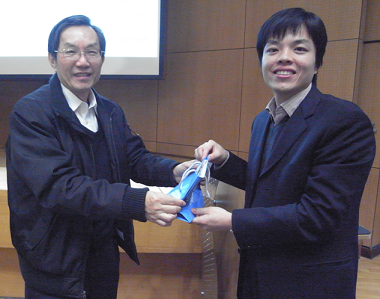 |
|
Professor Tsung-Hsien
Lin (right), and the host of
this speech, Professor Way-Seen Wang (left) |
|
|
March “GIPO
Colloquium” Highlights
(Compiled by Li-Chi Yao) |
|
Time: |
3:30 pm, Mar. 7 (Fri.), 2014 |
|
Speaker: |
Professor Shu-Ping Lau (The Hong Kong Polytechnic University) |
|
Topic:
|
Multicolor Light Emission from Chlorine-Doped Graphene Quantum Dots |
|
|
Professor Shu-Ping Lau visited GIPO on Mar. 7
(Fri.) and delivered a speech concerning “Multicolor Light Emission from Chlorine-Doped Graphene Quantum Dots” at lecture theater
101, Barry Lam Hall. His speech was rich in content and the professor interacted well with students. GIPO teachers and students participated in his speech with enthusiasm and benefited greatly from the experience. |
|
|
|
 |
|
The speaker, Professor Shu-Ping Lau |
|
|
|
3:30 pm, Mar. 14 (Fri.), 2014 |
|
Speaker: |
Professor
Chih-Cheng Wang, as known as Han-Hsiu
Lu (pen name), (Department of Applied Chinese Language, National Taichung University of Science and Technology) |
|
Topic: |
Walking on the Roads of Taiwan, the Course of My Life and its Connection with Literature |
|
|
Professor Chih-Cheng Wang, pen name as Han-Hsiu
Lu, visited GIPO on Mar. 14 (Fri.) and delivered a speech concerning “Walking on the Roads of Taiwan, the Course of My Life and its Connection with Literature” at
lecture theater 101, Barry Lam Hall. His speech was fascinating, and the professor interacted well with students. GIPO teachers and students participated in this event with enthusiasm and gained a great deal from the experience. Prof. Wang had been a writer of China Times’, writers commissioner for the newspaper, “Man’s World”, the deputy general-editor of the newspaper “Taiwan Daily”, a counselor of the Committee of Culture’s “Foundation for Culture Development”, a director of the “National Culture and Arts Foundation”, the deputy general-secretary of the “National Cultural Association”, and the commissioner of the “Bureau of Cultural Affairs, Kaohsiung City Government”. He is now absorbed in writing and teaching courses on modern poetry, Taiwanese pop songs, editing & reporting, and culture marketing at universities. |
|
|
|
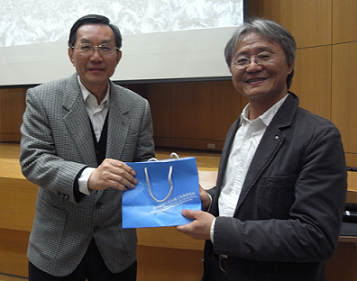 |
|
Professor Chih-Cheng Wang (right), and the host of this speech,
Professor Way-Seen Wang (left) |
|
|
|
3:30 pm, Mar. 21 ( Fri.), 2014 |
|
Speaker: |
Dr. Chin-Ti Chen (Institute of Chemistry, Academia Sinica) |
|
Topic: |
Organic Optoelectronic Materials and Devices |
|
|
Dr. Chin-Ti Chen visited GIPO on Mar. 21 (Fri.) and delivered a speech concerning “Organic Optoelectronic Materials and Devices” at lecture theater
101, Barry Lam Hall. His speech was interesting, and the professor interacted well with students. GIPO teachers and students took part in this event enthusiastically and gained a great deal from the experience. |
|
|
|
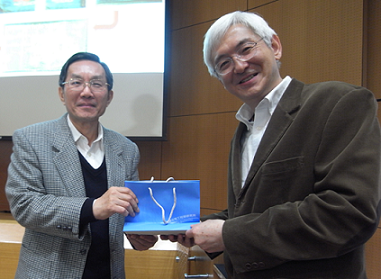 |
|
Dr. Chin-Ti Chen (right), and the host of this speech,
Professor Way-Seen Wang (left) |
|
|
|
3:30 pm, Mar. 28 (Fri.), 2014 |
|
Speaker: |
Professor Shi-Wei Chu (Department of Physics, National Taiwan University) |
|
Topic: |
Superresolution Optical Microscopy Based on Plasmonic Scattering |
|
|
Professor Shi-Wei Chu visited GIPO on Mar. 28
(Fri.) and delivered a speech concerning “Superresolution Optical Microscopy Based on Plasmonic Scattering” at lecture theater
101, Barry Lam Hall. Prof. Chu is a 2004 doctor graduate of GIPO,
and teaches in the Department of Physics, National Taiwan University. He is a particularly distinguished GIPO alumnus, and we have invited him not only to deliver his professional academic speech, but also to share, with his lower classmen at GIPO, his academic and career experiences as well. |
|
|
|
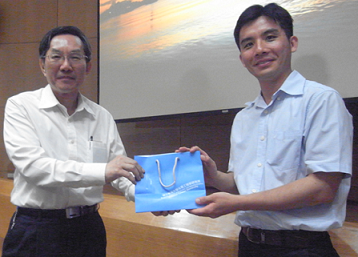 |
|
Professor Shi-Wei Chu (right), and the host of this speech,
Professor Way-Seen Wang (left) |
|
|
April “GIPO
Colloquium” Highlights
(Compiled by Li-Chi Yao) |
|
|
3:30 pm, Apr. 11 (Fri.), 2014 |
|
Speaker: |
Professor Tien-Lung Chiu (Department of Photonics Engineering, Yuan Ze University) |
|
Topic:
|
Organic Light-emitting Diode |
|
|
Professor Tien-Lung Chiu visited GIPO
on Apr. 11 (Fri.) and delivered a speech concerning “Organic Light-emitting Diode” at
lecture theater 101, Barry Lam Hall. The contents of his speech was fascinating, and the professor interacted well with students. GIPO teachers and students attended the speech with enthusiasm and benefited greatly from the experience. |
|
|
|
 |
|
Professor Tien-Lung Chiu (right), and the host of this speech,
Professor Way-Seen Wang (left) |
|
|
|
3:30 pm, Apr. 18 (Fri.), 2014 |
|
Speaker: |
Professor Fang-Chung Chen (Department of Photonics, National Chiao Tung University) |
|
Topic:
|
Light Harvesting Schemes for High-performance Polymer Solar Cells |
| |
Professor Fang-Chung Chen visited GIPO
on Apr. 18 (Fri.) and delivered a speech concerning “Light Harvesting Schemes for High-performance Polymer Solar Cells” at
lecture theater 101, Barry Lam Hall. His speech was rich in content and the professor interacted very well with students. GIPO teachers and students attended the speech with enthusiasm and benefited a great deal. |
| |
|
 |
|
Professor Fang-Chung Chen (right), and the host of this speech,
Professor Way-Seen Wang (left) |
|
~ GIPO Laboratories’ Small Emergency Response Drill ~
(Time: 11:10 am ~ 11:40 am, Apr. 11, 2014)
Composed by
Tzu-Yu Chen
Drill location:
The
following 14 laboratories on the west side of
the 3rd floor of
EE-II
Building: lab 301A, lab 301B, lab 305A, lab
305B, lab 306A, lab 306B, lab 307A, lab 307B,
lab 350, lab 351A, lab 351B, lab 352A, lab 352B,
and lab 354.
Drill details:
The main purpose of this drill is for rescuers to perform their duties correctly, use appropriate rescue methods, and control the situation efficiently in times of emergency. Moreover, all students and staff studying or working in the laboratories are required to become familiar with escape routes and methods so as to cope with urgent situations and escape safely.
This drill is set under the supposition that, at 11:10 am, some students in lab 306A, a poisonous substance laboratory in
EE-II
Building, experiences leakage of a toxic substance while performing an experiment.
In the emergency, the students immediately inform GIPO office that students and staff in the building have to be evacuated. After having received the message, GIPO office immediately informs
EE-II
Building office to broadcast the news and direct all personnel in the building to move towards exits at once.
GIPO office also sends staff to the north, west and south exits to help direct those evacuating to escape and stay far enough away from the building, and to make sure that all personnel have been evacuated.
Right after having given
EE-II
Building office the notice, GIPO office then informs Prof. Chih-I Wu, the staff in charge of the lab
306A, Prof. Gong-Ru Lin, GIPO chairman, Prof. Jian-Jang Huang, GIPO
vice
chairman, and Prof. Jui-Che Tsai, GIPO environment protection/occupation safety/health commissioner, meet at the north exit square, where the GIPO
chairman will assign each one’s mission according to the situation.
After the environment protection/occupation safety/health commissioner has confirmed that all personnel in the building have been safely evacuated, this drill is completed accordingly.
The drill has indeed strengthened our knowledge of dealing with emergencies, i.e. immediate reporting and urgent evacuation. Finally, we wish to thank GIPO teachers, office staff, and students for your kind cooperation in this event.
A quick review of the drill and suggestions for improvement:
1. Some students and staff, upon hearing the evacuation broadcast, still remained in or went into labs, which obviously contradicts the evacuation direction.
2. Some students and staff, upon hearing the evacuation broadcast, hesitated and lingered in the corridor and did not move toward exits at once.
|
 |
 |
|
Lab 306A,
EE-II
Building, reports the leakage to GIPO office. |
Having received the message, GIPO office immediately informs EE office to begin broadcasting. |
|
 |
 |
|
EE office staff broadcasts the information to all labs. |
GIPO office sends staff to direct the evacuation. |
|
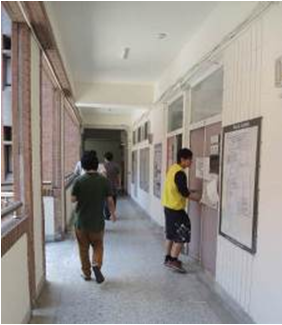 |
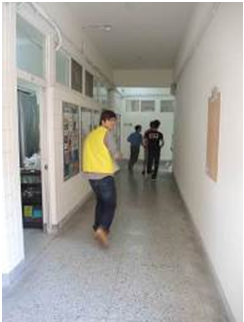 |
|
Students of lab 306A go to neighboring labs to inform them of the leakage and ask them to evacuate. |
Students and staff of all labs move towards exits. |
|
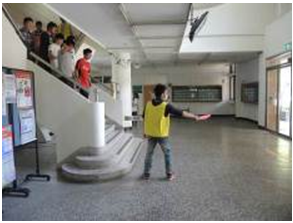 |
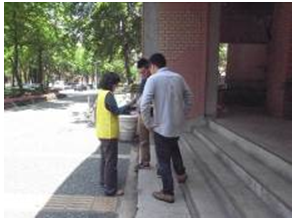 |
|
The evacuation at west
exit |
Those evacuated from the west exit are checked against a name list. |
|
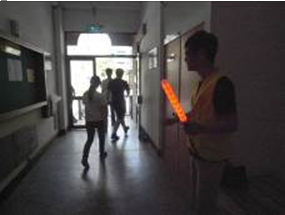 |
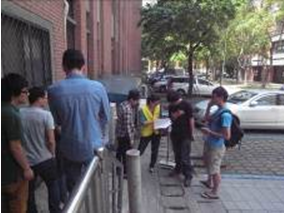 |
|
The evacuation at
north exit |
Those evacuated from the north exit are checked against a name list. |
|
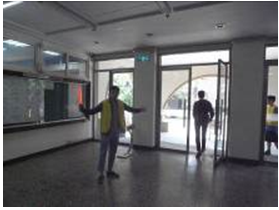 |
 |
|
The evacuation at
south exit |
Those evacuated from the south exit are checked against a name list. |
|
 |
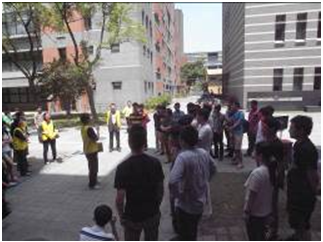 |
|
It is confirmed that all personnel in
the building have been evacuated; the
result is then reported to the Chairman. |
All those evacuated have been assembled at the square north of the building. |
|
 |
|
 |
|
| |
|
 |
High Efficiency
Organic – Inorganic Hybrid Solar Cells by
employing flexible film-Silicon with
Hierarchical Surface
Professor Ching-Fuh Lin
Graduate Institute of Photonics and
Optoelectronics, National Taiwan University
Crystalline silicon (c-Si) photovoltaics (PVs) have
dominated PV industry for several decades. However, current crystalline-silicon
solar cells based on thick wafers have little flexibility, so limiting their
applications on curved or bendable surfaces. Highly flexible and light-weight
solar energy devices have received significant attention owing to their
potential inspiration provided in various modern applications such as robotics,
portable electronics, flexible displays, building windows, curved building
structures and other systems. In recent years, fabulous progresses have been
made in developing flexible and thin-film solar cells that can be potentially
massively deployed.
On the other hand, conventional silicon solar cells
have thickness in the range of 180-200 μm, which limits their flexibility.
Therefore, exploring flexible single-crystalline-film-silicon solar cells
without exploiting highly expensive and complicated methods are very attractive.
We demonstrate a high-efficiency organic – inorganic hybrid solar cell
Si/PEDOT:PSS with hierarchical surface composed of silicon nanoholes and
micro-desert textures, showing a power conversion efficiency of 12%. Such
Si/PEDOT:PSS hybrid solar cells exhibit high Jsc of 36.81mA/cm2,
Voc of 0.492V, FF of 66.3%, and thus PCE of 12.00%. The hierarchical
surface provides an excellent light absorption over 97% for the spectral range
of 300 nm to 1100 nm with the thickness of 60µm due to internal multiple
reflections caused by subwavelength features of high density silicon nanoholes
and micro-desert textures. At an angle of incidence up to 65º, the
reflectance maintains less than 0.7% and at the large angle of 75º
the value is still less than 1%. In addition, we made the back surface of
flexible-Si as a highly doped n-type layer to reduce the surface recombination
rate and decrease the contact resistance.
|
 |
 |
|
Fig. 1 shows that optical measurement of wide range of AOI and wavelength for the thin wafer with silicon nanohole. |
Fig. 2 shows that high efficiency hybrid solar cells are demonstrated by employing flexible thin silicon with Hierarchical surface composed of high-density nanoholes on micro-desert textures. |
Investigation of
focused ion beam milling process
Professor Chieh-Hsiung Kuan
Graduate Institute of Photonics and
Optoelectronics, National Taiwan University
Focused ion beam (FIB) technique enables
nanomachining of materials directly and site-specifically. Some kinds of surface
structures which require complex conventional processes to fabricate can be
facilely obtained with FIB. During a FIB machining process, the desired patterns
are milled with a scan of adjacent ion beam spots. In this study, we
investigated the surface topography evolution of Si(001) milled with a single Ga+
beam spot of different dwell time.
Fig. 1 shows typical AFM images of
single-spot-milled Si(001) surfaces. For the samples of short dwell time, the
surface shows a protruding topography which comes from the amorphization of Si
after a low dose of ion bombardment (swelling effect). As the dwell time exceeds
1 ms, the milling process begins to dominate. The depth at each radial distance
of the pit varies almost linearly with dwell time in the range of 1.5-84 ms
(Fig. 2). In addition, the slopes of the depth-dwell time graph can be
approximately described by a Gaussian function of radial distance (Fig. 3). Thus
the surface profiles of the milled pits can be effectively expressed as an
equation of radial distance and dwell time. Fig. 4 shows the calculated profiles
as well as the AFM data. The difference between measured and calculated values
is within only 3 nm. Based on these results, 3D surface structures can be
accurately realized for further device applications.
|
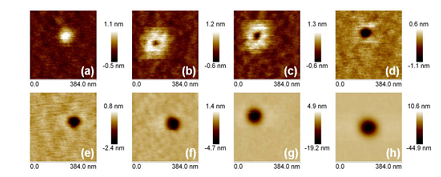 |
|
Fig. 1. AFM images of Si(001) surfaces after the process of single spot milling with a dwell time of (a) 88 μs, (b) 445 μs, (c) 667 μs, (d) 1.5 ms, (e) 3.3 ms, (f) 7.4 ms, (g) 16.7 ms, and (h) 38 ms. |
|
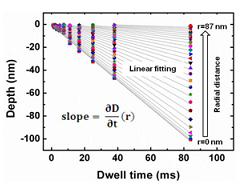 |
|
Fig. 2. Change of depth with dwell time at each radial distance of the pit. The slopes decrease outward from the center. |
|
 |
|
Fig. 3. Change of the slope of depth-dwell time graph (Fig. 2) with radial distance. The red solid line represents a Gaussian fitting curve. |
|
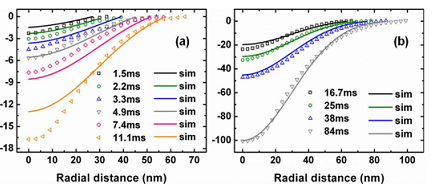 |
|
Fig. 4. Calculated depth profiles (solid lines) as well as the AFM data (hollow dots). The difference between measured and calculated values is within 3 nm. |
Collinear and
non-collinear multi-wavelength optical
parametric generation in 1D PPLT
Professor
Lung-Han Peng
Graduate Institute of
Photonics and
Optoelectronics,
National Taiwan
University
We demonstrated multiple wavelengths optical
parametric generation (OPG) from a single grating, one dimensional periodically
poled lithium tantalate crystal. Such OPG spectra are found in continuous
spatial positions symmetrical to the collinear direction, with decreasing signal
and increasing idler wavelengths, associated with decreasing powers when the
far-field angle increases. These observations were ascribed to the simultaneous
collinear and non-collinear optical parametric generation (OPG) processes due to
the pump intensity and the resultant wavelength-dependence on the angular
bandwidth of the parametric gain.
This work was collaborated with Prof. Boudrioua of
U. Paris 13, France and Prof. Simohamed of´ Éole Militaire Polytechnique
(Algeria)
|
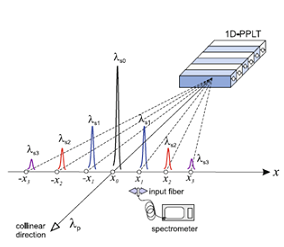 |
|
Fig. 1. Spatial dispersion of the generated spectrum |
|
 |
|
Fig. 2. Generated OPG spectra recorded at different symmetrical spatial positions |
|
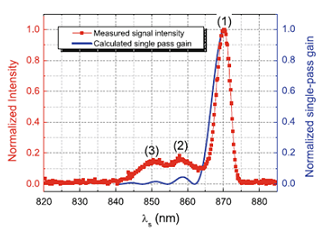 |
|
Fig. 3. Calculated single-pass gain spectra and measured signal wave intensities |
Ref: M. Lazoul, A. Boudrioua, L. M.
Simohamed, A. Fisher, and L.-H. Peng, “Simultaneous collinear and non-collinear
parametric generation in 1D single grating periodically poled lithium
tantalate,” Appl. Phys. B 110, 459 (2013).
Spectroscopic
measurement of absorptive thin films by
spectral-domain optical coherence tomography
Professor
Sheng-Lung Huang's
Laboratory
Graduate Institute of
Photonics and
Optoelectronics, National
Taiwan University
A non-invasive method for measuring the refractive
index, extinction coefficient and film thickness of absorptive thin films using
spectral-domain optical coherent tomography is proposed, analyzed and
experimentally demonstrated. Such an optical system employing a normal-incident
beam of light exhibits a high spatial resolution. There are no mechanical moving
parts involved for the measurement except the transversal scanning module for
the measurement at various transversal locations. The method was experimentally
demonstrated on two absorptive thin-film samples coated on transparent glass
substrates. The refractive index and extinction coefficient spectra from 510 to
580 nm wavelength range and film thickness were simultaneously measured. More
info can be found at Optics Express, 22, No. 5, pp. 5675–5683, 2014.
|
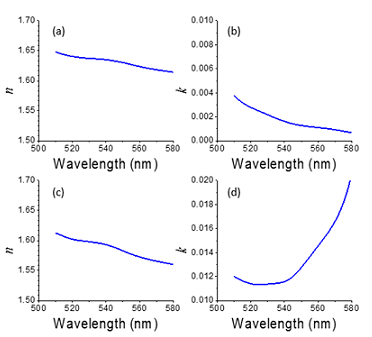 |
|
Figure: The dispersions of index refraction and extinction coeff. of a yellow (a, b) and a green (c,d) color filters. |
|
|
|
 |
|
 |
|
| |
|
|
 |
|
 |
|
|
|